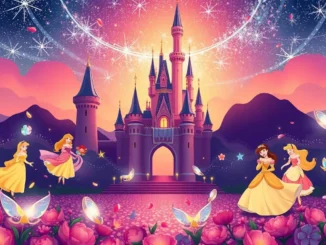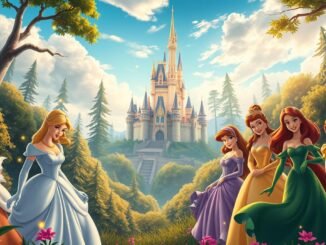
Pixar animation has revolutionized the film industry with its captivating storytelling and visually stunning creations. Since its inception, Pixar has been a pioneer in the world of animated films, pushing the boundaries of technology and art.
The studio’s journey began with a commitment to innovation and creativity, resulting in the production of the first full-length computer-animated film, Toy Story, in 1995. This milestone marked the beginning of a new era in animation, with Pixar at the forefront.
With a legacy spanning decades, Pixar animation has become synonymous with quality and compelling narratives, as seen in films like Incredibles 2, which holds the record for the highest-grossing animated movie at the North American box office.
Key Takeaways
- Pixar has been a pioneer in the animation industry, driving technological advancements.
- The studio’s commitment to innovation has led to the creation of beloved films.
- Pixar’s collaboration with Disney has resulted in significant technological advancements.
- The studio continues to push the boundaries of storytelling and animation.
- Pixar’s films are known for tackling big themes and feelings in an accessible way.
The Genesis of Pixar Animation Studio
The Pixar Animation Studio was born out of a passion for innovation and storytelling. As a pioneering computer animation studio, Pixar’s early days were marked by experimentation and creativity, laying the groundwork for its future success.
The Founding Visionaries
Ed Catmull and Alvy Ray Smith were among the key figures who founded Pixar, bringing with them a vision for computer-generated imagery. Their mission was to push the boundaries of animation technology, collaborating with experts from various fields to achieve groundbreaking results.
- Ed Catmull, a computer scientist and animator, played a crucial role in developing Pixar’s animation technology.
- Alvy Ray Smith, a renowned computer graphics expert, contributed significantly to the development of Pixar’s early projects.
Early Projects and Breakthroughs
Pixar’s early projects were characterized by innovative storytelling and technological advancements. One of its first major breakthroughs came with the production of short films that showcased the studio’s capabilities in computer-generated imagery.
- The production of “Tin Toy,” a short film that won an Academy Award, marked a significant milestone for Pixar.
- Collaborations with Disney on projects like “The Brave Little Toaster” demonstrated Pixar’s potential in the animation industry.
The partnership with Disney ultimately led to the creation of “Toy Story,” a film that revolutionized the animation industry and cemented Pixar’s status as a leading computer animation studio. The success of Pixar and Disney’s collaboration, often referred to as Disney Pixar, paved the way for future animated classics.
Innovative Animation Techniques
At the heart of Pixar’s success lies its innovative animation techniques, which have set a new standard for the industry. The studio’s commitment to pushing the boundaries of what is possible in animation has led to the development of several groundbreaking technologies and methodologies.
Computer-Generated Imagery (CGI) Revolution
The introduction of Computer-Generated Imagery (CGI) marked a significant turning point in the history of animation. Pixar was at the forefront of this revolution, leveraging CGI to create visually stunning films that captivated global audiences. Toy Story, released in 1995, was the first feature-length film to utilize CGI, setting a new benchmark for animated storytelling.
The impact of CGI on the animation industry cannot be overstated. It allowed for greater control over the animation process, enabling the creation of complex characters and environments that were previously unimaginable. The success of Toy Story and subsequent Pixar films demonstrated the potential of CGI, paving the way for its widespread adoption across the industry.
Storyboarding and Character Design
Effective storyboarding and character design are crucial elements in the creation of engaging animated narratives. Pixar’s storyboarding process involves meticulous planning to ensure that the story flows smoothly and that the pacing is well-balanced. Character design is equally important, as it brings the story’s personalities to life. Pixar’s characters, such as Woody and Buzz Lightyear, are designed to be both visually appealing and emotionally resonant.
- Storyboarding allows for the visualization of the narrative’s sequence and pacing.
- Character design focuses on creating memorable and relatable characters.
- The combination of these elements helps to create a compelling story.
The Role of Technology in Animation
Technology plays a vital role in Pixar’s animation process, driving innovation and enabling the studio to achieve its creative vision. Advances in animation software and rendering technology have significantly enhanced the studio’s capabilities, allowing for more complex and detailed animations. The continuous evolution of technology ensures that Pixar remains at the forefront of animation, capable of producing high-quality films that captivate audiences.
Pixar’s embrace of technological innovation is evident in its development of proprietary software and tools, designed to meet the specific needs of its filmmakers. This commitment to technological advancement has been a key factor in the studio’s success, enabling it to push the boundaries of what is possible in animation.
Iconic Pixar Films and Their Impact
With a legacy of creating beloved animated movies, Pixar has left an indelible mark on the entertainment industry. The studio’s films have not only captivated audiences worldwide but have also pushed the boundaries of digital animation.
“Toy Story” – A Groundbreaking Milestone
Released in 1995, “Toy Story” was the first full-length film to be produced entirely with computer-generated imagery (CGI). This innovative approach to storytelling revolutionized the animation industry, paving the way for future animated movies. The film’s success can be attributed to its engaging storyline, memorable characters, and the groundbreaking use of CGI, which set a new standard for digital animation.
For more information on upcoming animated films, you can visit Disney’s Upcoming Movie Lineup, which provides insights into the latest developments in the world of animation.
Emotional Storytelling in Pixar Classics
One of the key factors contributing to Pixar’s success is its ability to craft emotionally resonant stories. Films like “Inside Out,” “Coco,” and “Up” have demonstrated the studio’s capacity to tackle complex themes and emotions, making their movies relatable and impactful. By focusing on character development and storytelling, Pixar has been able to create a deep emotional connection with its audience.
Awards and Accolades
Pixar’s contributions to digital animation and animated movies have been recognized globally, with numerous awards and accolades. The studio has received multiple Academy Awards, Golden Globe Awards, and Annie Awards, among others. These accolades are a testament to Pixar’s commitment to innovation and excellence in storytelling.
Behind the Scenes: The Creative Process
Behind every Pixar film lies an intricate web of artistic decisions and technical innovations. The creative process at Pixar Animation Studios is a complex, multi-layered endeavor that involves numerous talented artists and technicians working together to bring stories to life.
Collaboration Among Artists
The development of Pixar movies is a highly collaborative process. Artists, writers, and directors work together to conceptualize and refine the story, characters, and overall narrative arc. This collaborative environment fosters a culture of innovation and creativity, allowing artists to share their ideas and expertise to create something truly unique.
For instance, the storyboarding process is a critical phase where artists create a visual representation of the film’s sequence. This process involves iterative feedback and refinement, ensuring that the pacing, tone, and emotional resonance of the story are well-balanced.
Voice Acting and Music Integration
Voice acting and music play crucial roles in bringing Pixar characters to life. The selection of voice actors is a meticulous process, with directors seeking actors who can convey the desired emotional depth and nuance. The music composition is equally important, as it enhances the emotional impact of key scenes and complements the narrative.
For example, in Toy Story, the voice acting talents of Tom Hanks and Tim Allen brought Woody and Buzz Lightyear to life, while the score by Randy Newman added a layer of nostalgia and warmth to the film.
| Key Elements | Description | Impact on Pixar Movies |
|---|---|---|
| Collaboration | Artists, writers, and directors work together to develop the story and characters. | Enhances creativity and innovation in storytelling. |
| Voice Acting | Talent selection for character voices. | Adds emotional depth and nuance to characters. |
| Music Integration | Composition to enhance emotional impact. | Complements the narrative and enhances key scenes. |
The Future of Pixar Animation
As Pixar continues to push the boundaries of storytelling and technology, the studio is poised to captivate audiences with its upcoming projects. The future of Pixar animation is bright, with a focus on innovative techniques and diverse storytelling.
New Horizons in Storytelling
Pixar animation is embracing diversity in its narratives, providing a fresh perspective on traditional themes. This shift is expected to resonate with a broader audience, making Pixar films more relatable and engaging.
Advancements in Animation Technology
The evolution of animation technology is a key driver of Pixar’s success. With ongoing innovations in computer-generated imagery (CGI) and other areas, Pixar is set to continue delivering visually stunning films that inspire and entertain.
By combining creative storytelling with cutting-edge technology, Pixar animation is well-positioned to remain at the forefront of the animation industry. As the studio continues to evolve, audiences can look forward to new and exciting experiences.
FAQ
What is Pixar Animation Studios known for?
Pixar Animation Studios is renowned for its high-quality computer-animated films, captivating storytelling, and memorable characters, making it a leader in the animation industry.
What was the first feature-length film produced by Pixar?
The first feature-length film produced by Pixar was “Toy Story,” released in 1995, which revolutionized the animation industry with its groundbreaking CGI animation.
How has Pixar contributed to the development of CGI animation?
Pixar has been at the forefront of CGI animation, pushing the boundaries of what is possible with computer-generated imagery and influencing the industry as a whole with its innovative techniques.
What are some of the most iconic Pixar films?
Some of the most iconic Pixar films include “Toy Story,” “Finding Nemo,” “The Incredibles,” “Up,” and “Inside Out,” all of which have received critical acclaim and have been beloved by audiences worldwide.
How does Pixar approach storytelling in its films?
Pixar is known for its emphasis on emotional storytelling, creating narratives that resonate with audiences on a deep level and exploring complex themes in a way that is both entertaining and accessible.
What role does technology play in Pixar’s animation process?
Technology plays a crucial role in Pixar’s animation process, enabling the studio to create visually stunning films with complex characters and environments, and driving innovation in the field of computer animation.
How has Pixar’s partnership with Disney impacted its success?
Pixar’s partnership with Disney has been instrumental in its success, providing the studio with the resources and support needed to produce high-quality films and reach a wider audience.
What can we expect from Pixar in the future?
As Pixar continues to evolve, we can expect to see new and innovative films that push the boundaries of animation and storytelling, as well as a continued emphasis on diversity and representation in its narratives.



